Adicionar um favicon ao seu blog do WordPress é uma etapa simples, porém poderosa, para a marca do seu site. Um favicon é uma pequena imagem que aparece ao lado do título do seu site nas guias do navegador, nos favoritos e muito mais.
O problema é que muitos blogueiros novos ignoram esse detalhe ou acham que ele é muito técnico para ser resolvido. Por outro lado, a falta de um favicon pode dificultar a identificação do seu site pelo público-alvo em um piscar de olhos, o que pode reduzir o retorno de visitas ou o envolvimento.
No WPBeginner, um dos motivos pelos quais usamos um favicon é para ajudar nossos leitores a reconhecer rapidamente nosso site entre suas guias abertas e favoritos. Esse detalhe também ajuda a reforçar nossa marca e a garantir uma presença on-line mais profissional.
Felizmente, adicionar um favicon ao seu blog do WordPress não precisa ser complicado. Neste guia, abordaremos métodos fáceis para configurar o ícone do seu site e fazer com que seu blog se destaque.
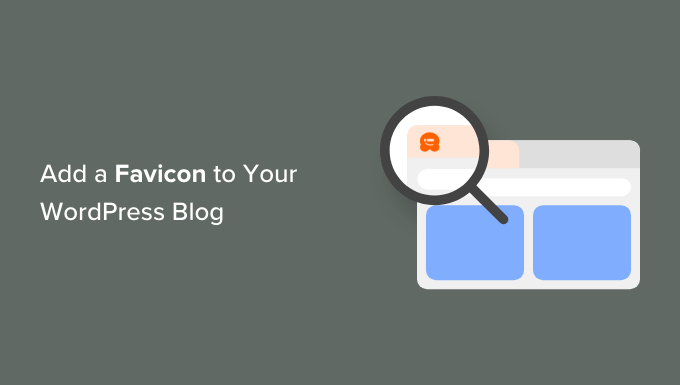
Por que você deve adicionar um Favicon ao seu blog WordPress?
É essencial adicionar um favicon ao seu blog do WordPress porque ele ajuda os usuários a identificar seu site rapidamente e a fortalecer a identidade da sua marca. Com esse pequeno ícone, os visitantes do site podem reconhecer facilmente seu blog.
Esta é a aparência de um favicon em um navegador da Web:

Outra finalidade de um favicon do WordPress é melhorar a experiência do usuário. Quando várias guias estão abertas, os usuários podem olhar para os favicons para saber em qual site estão e mudar para aquele que desejam.
Se os usuários adicionarem um ícone de atalho ou um marcador ao seu blog em seus dispositivos móveis, o favicon aparecerá como um ícone de aplicativo na tela inicial. Isso facilita o acesso ao seu site com um simples toque.
Os favicons também podem ajudar na otimização do mecanismo de pesquisa (SEO) do WordPress. Se você prestar atenção às páginas nos resultados de pesquisa, elas geralmente apresentam o favicon do site antes do metatítulo da página. Isso pode fazer com que seu site pareça legítimo e confiável.
Como criar um favicon para seu blog WordPress
Primeiro, vamos aprender a criar um bom favicon para seu blog.
O tamanho ideal do favicon do WordPress é uma imagem quadrada de até 512 pixels de largura e altura. O formato da imagem do favicon pode ser ICO, JPEG, PNG ou GIF.
O SVG também é um formato comum para favicons, mas não é aceito pelo WordPress por padrão. Dito isso, você pode configurar o WordPress para permitir a adição de arquivos SVG.
Se você tiver um blog comercial, poderá usar o logotipo da sua marca como ícone de favicon. Se você ainda não tem um, consulte nosso guia para iniciantes sobre como criar um logotipo para seu site.
Se você tiver um logotipo pronto, mas quiser deixar o plano de fundo transparente, poderá usar o Photoshop ou uma ferramenta gratuita de edição de imagens com um removedor automático de plano de fundo. Apenas certifique-se de que o formato do arquivo seja PNG para manter a transparência no favicon.
Outra opção que você pode usar é um gerador de favicon gratuito, como o Favicon.io. Essa ferramenta permite que você personalize um favicon do zero e baixe os arquivos nos formatos PNG e ICO.
Com isso em mente, veja a seguir como adicionar facilmente um favicon ao seu blog do WordPress. Abordaremos quatro métodos, e você pode clicar nos links abaixo para ir para o método que deseja usar:
Pronto? Vamos começar.
Método 1: Adicionar um favicon usando o personalizador do WordPress
Esse é o método mais fácil de alterar um favicon no WordPress. Tudo o que você precisa fazer é carregar sua imagem de favicon no Personalizador do WordPress, e o resto será resolvido para você.
A primeira etapa é acessar o WordPress Customizer. Se você usa um tema clássico, pode navegar até Appearance ” Customize para fazer isso.
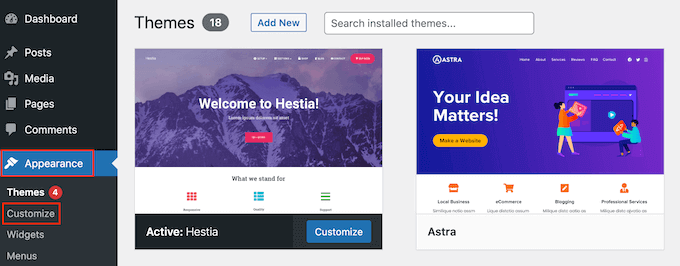
Se estiver usando um tema de bloco e não conseguir encontrar o Customizer, consulte nosso guia sobre como corrigir a falta do Theme Customizer no administrador do WordPress.
Em seguida, clique na guia “Site Identity” (Identidade do site) na barra lateral esquerda.
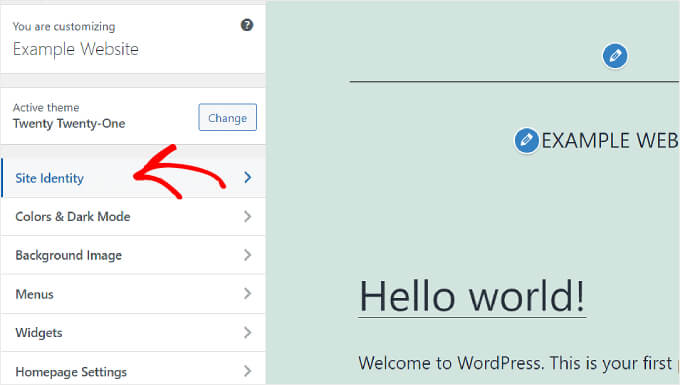
Aqui, você verá opções para personalizar o “Logotipo do site”, “Título do site”, “Slogan” e “Ícone do site”.
Se quiser adicionar o favicon de um site, você precisará rolar para baixo até a seção “Site Icon” (Ícone do site) e clicar em “Select site icon” (Selecionar ícone do site).
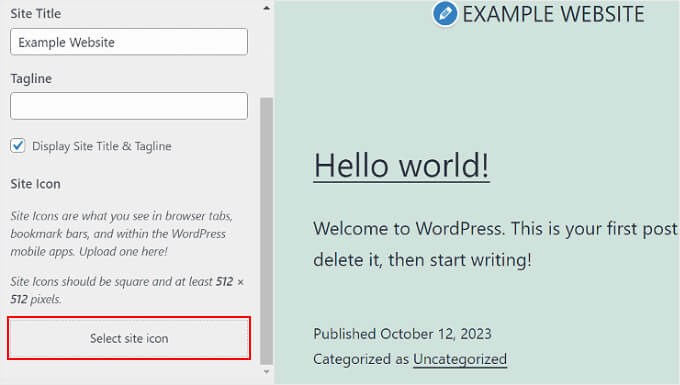
A Biblioteca de mídia do WordPress será exibida. Você pode selecionar uma imagem existente ou carregar um novo favicon personalizado de seu computador.
Neste exemplo, usaremos o logotipo do WPBeginner como o ícone do site do WordPress.
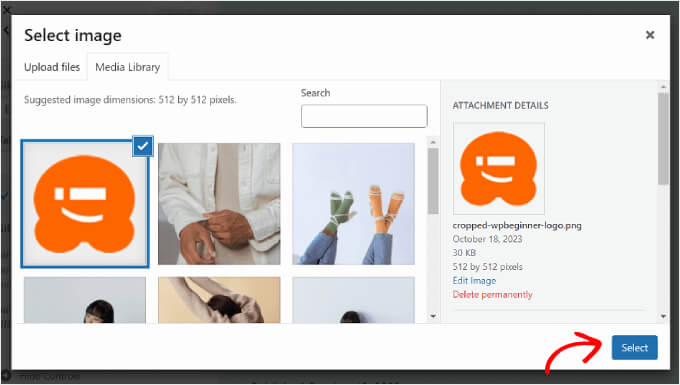
Depois de escolher uma imagem, clique no botão “Select” (Selecionar) no canto inferior direito da janela.
Se o favicon for maior do que o tamanho recomendado, o WordPress permitirá que você o recorte. Se ele corresponder exatamente ao tamanho recomendado, você poderá deixá-lo como está.
Quando a imagem estiver boa, basta clicar em “Crop image” (Cortar imagem).
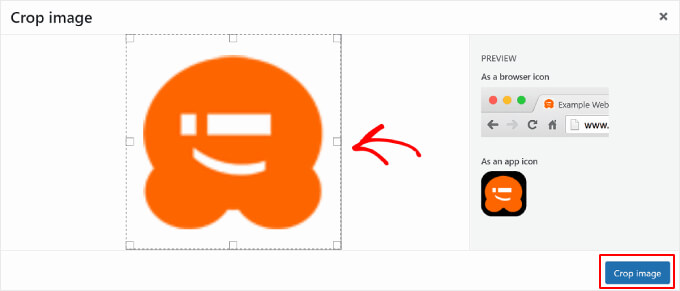
Depois disso, você voltará ao Personalizador do WordPress. Aqui, você pode concluir a configuração do favicon clicando no botão “Publicar” na barra lateral esquerda.
É isso aí! Agora que você carregou seu favicon, pode visitar seu site do WordPress para ver se a imagem já está ativa.
Método 2: Adicionar um favicon usando o editor de site completo do WordPress
Se você estiver usando um tema de bloco e quiser adicionar o logotipo da sua marca como parte do cabeçalho do site e como ícone do site, esse método é para você.
Para isso, você precisa ir para Appearance ” Editor no painel de administração do WordPress.
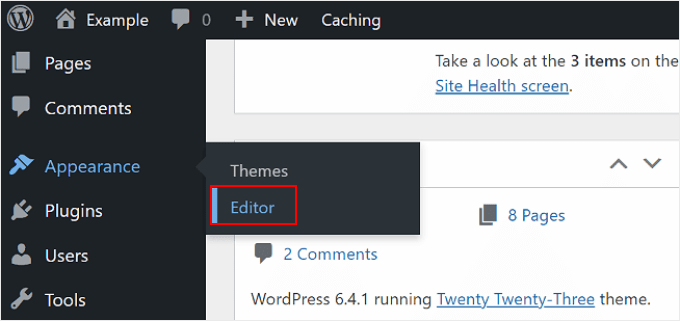
Nessa página, você encontrará vários menus para personalizar seu site, incluindo “Navigation” (Navegação) e “Styles” (Estilos).
Para este tutorial, você precisará clicar em “Patterns” (Padrões) para acessar o padrão de bloco de cabeçalho do site.
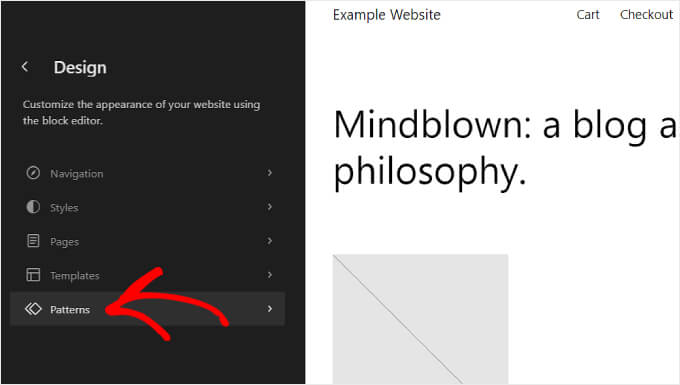
Ao rolar a tela para baixo, você verá várias partes do modelo:“Header” (Cabeçalho), “Footer” (Rodapé) e “General” (Geral).
Basta clicar no modelo “Header” (Cabeçalho) para adicionar seu favicon.
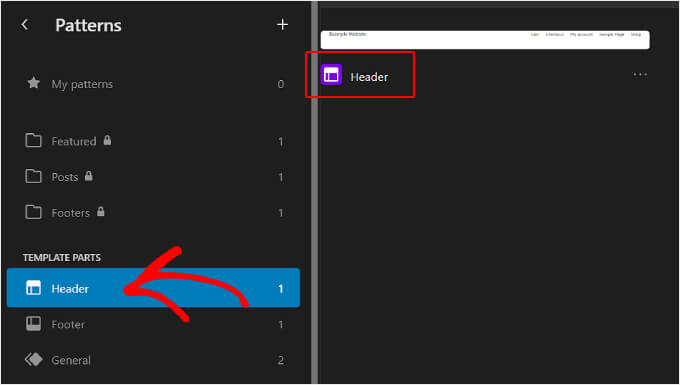
Em seguida, você verá um botão de lápis ao lado do texto do cabeçalho.
Clique nele para que você possa editar o padrão e inserir seu favicon do WordPress.
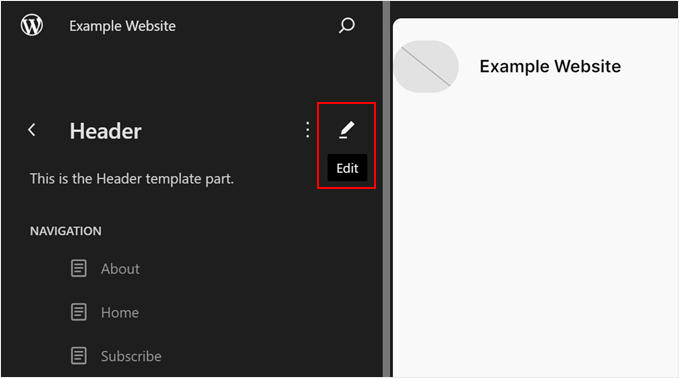
Agora você está dentro da experiência de edição completa do site do WordPress.
A partir daí, você pode clicar no botão “+” de adicionar bloco e procurar o bloco “Site Logo”. É aqui que você adicionará a imagem que se tornará seu favicon do WordPress.
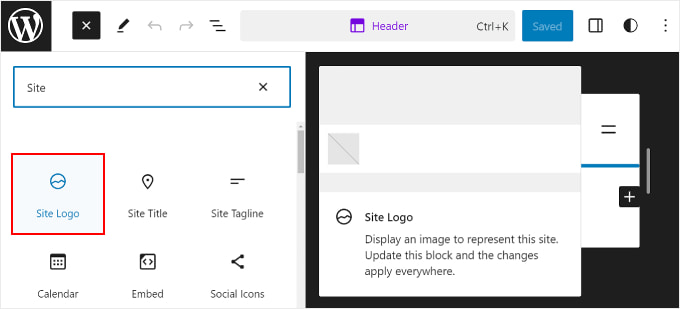
Sinta-se à vontade para arrastar e soltar o bloco para onde quiser em seu cabeçalho. Neste exemplo, nós o colocamos ao lado do título do site.
A próxima coisa que você fará é clicar no ícone de upload no bloco “Site Logo”.
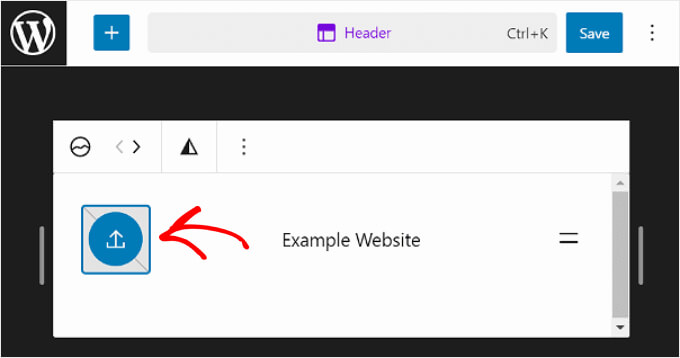
Como no método anterior, você pode escolher uma imagem existente ou carregar uma nova imagem da Biblioteca de mídia do WordPress.
Depois disso, você precisa navegar até a barra lateral de configurações do bloco no lado direito da página. Basta ativar a configuração “Usar como ícone do site” para adicionar o logotipo como um favicon.
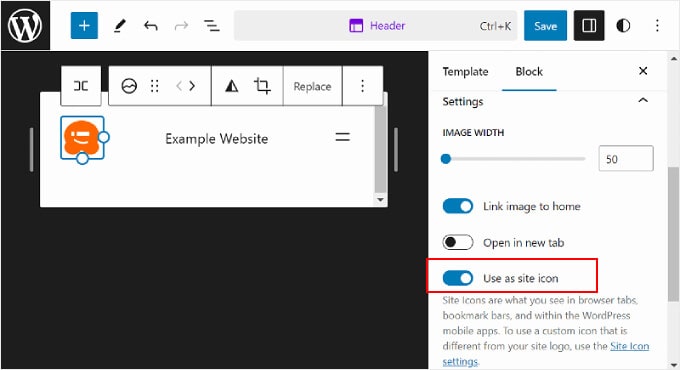
Por fim, você pode clicar no botão “Save” (Salvar) no canto superior direito da página para publicar seu favicon.
Você verá um aviso de que a alteração afetará todo o site. Apenas certifique-se de que a caixa “Ícone” esteja marcada e clique em “Salvar” novamente.
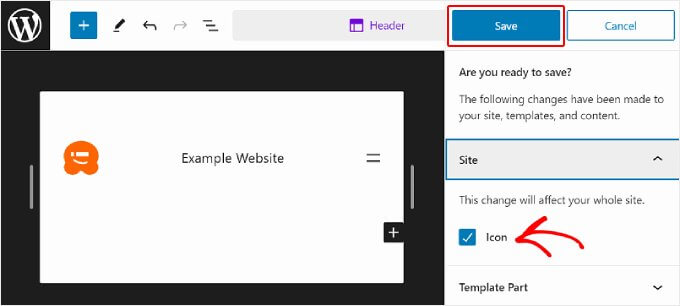
Agora que você passou por todas as etapas, pode abrir seu site para confirmar que a alteração foi bem-sucedida.
Método 3: Adicionar um favicon usando um plug-in de favicon do WordPress
Se preferir usar um plug-in de favicon do WordPress, você pode seguir este método para usar o plug-in gratuito Favicon by RealFaviconGenerator.
Primeiro, você precisa instalar e ativar o plug-in. Para obter mais detalhes, você pode seguir nosso guia sobre como instalar um plug-in do WordPress.
Depois de ativado, você pode ir para Appearance ” Favicon no painel do WordPress.
Depois disso, basta clicar no botão “Select from the Media Library” para carregar uma nova imagem ou usar uma já existente.
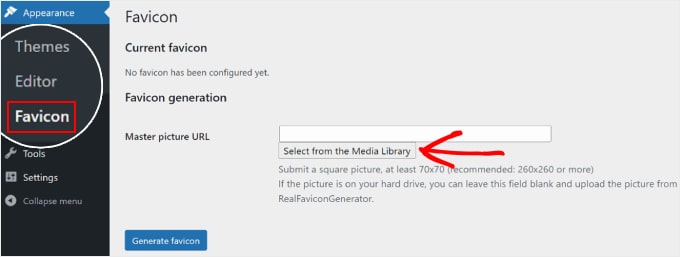
Observe que você precisará usar uma imagem quadrada. O plug-in recomenda que o ícone do site tenha pelo menos 260 pixels de largura e altura, mas não menos que 70 pixels.
Depois de escolher uma imagem, vá em frente e clique no botão “Generate favicon” (Gerar favicon).
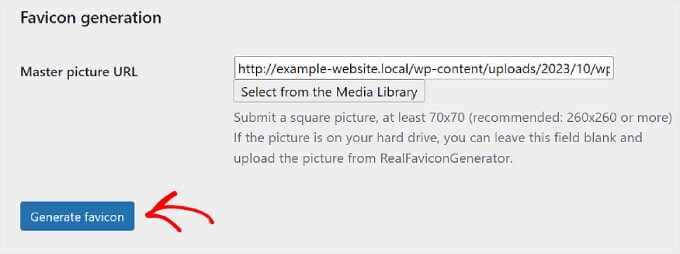
Depois disso, o plug-in o levará ao site RealFaviconGenerator para editar o favicon.
Você pode personalizar várias configurações, como a cor do plano de fundo e a aparência nas páginas de resultados de pesquisa do Google (SERPs), iOS, Android, macOS Safari, Chrome e Windows Metro.
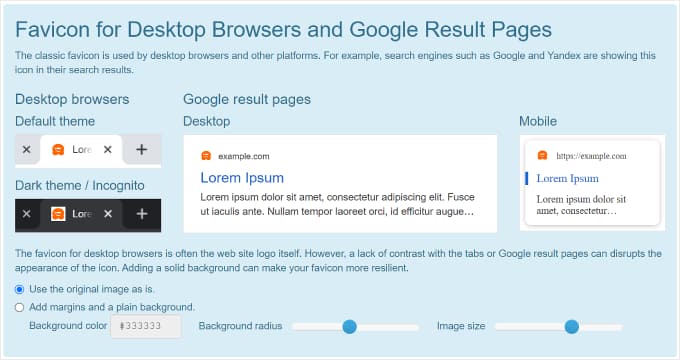
Na seção “Favicon Generator Options” (Opções do gerador de favicon), você pode marcar a caixa para ver se o seu site já usou um favicon antes. Em caso afirmativo, basta inserir um número no segundo campo para indicar a versão do favicon que está usando.
Dessa forma, os usuários que já visitaram seu site anteriormente verão o novo favicon em vez do antigo.
Quando tudo estiver certo, tudo o que você precisa fazer é clicar no botão “Generate your Favicons and HTML code” (Gerar seus favicons e código HTML) para adicionar o favicon ao seu site WordPress.
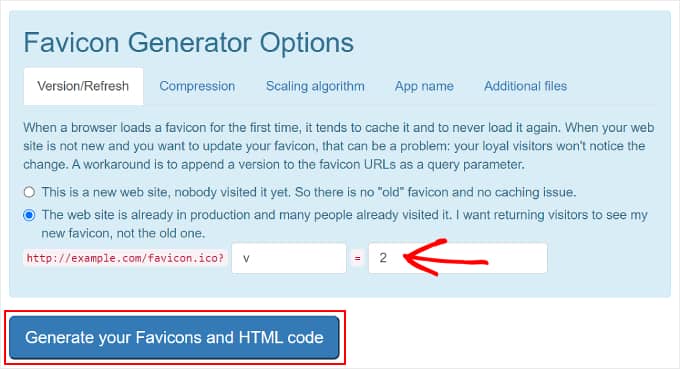
Seu favicon agora deve estar ativo. Certifique-se de manter o plug-in de favicon do WordPress ativo para que o favicon esteja sempre ativado.
Método 4: Adicionar um favicon manualmente ao seu blog WordPress
Por último, mas não menos importante, você pode adicionar um favicon do WordPress ao seu blog editando manualmente os arquivos de código do seu tema.
Isso é útil se o Theme Customizer não tiver a seção “Site Identity” ou se você usar um tema de bloco e quiser uma imagem de favicon diferente do logotipo do site.
A maneira mais fácil e segura de editar os arquivos de código do seu tema é com o plug-in WPCode.
O WPCode é o melhor plug-in de snippets de código para iniciantes. Com mais de 1.700 snippets prontos e tratamento seguro de erros, ele permite que você insira códigos personalizados com segurança sem danificar seu site.

Outra vantagem do WPCode é que, se você atualizar o tema, não perderá as modificações de código, inclusive o favicon.
Para este guia, você pode usar a versão gratuita do WPCode. No entanto, com a assinatura Pro, você tem acesso a recursos como lógica condicional inteligente e integrações de terceiros para gerenciar seu código com mais eficiência.
Para começar, você precisa instalar e ativar o WPCode. Para obter mais informações, consulte nosso guia passo a passo sobre como instalar um plug-in do WordPress.
A próxima coisa que você precisa fazer é preparar seus arquivos de favicon. Para isso, você pode usar um gerador de favicon gratuito, como o Favicon.io.
No site, você pode clicar em “Image” (Imagem) para converter um arquivo de imagem em um arquivo zip e código HTML. Como alternativa, você pode usar a opção “Emoji” ou “Texto” para criar um favicon usando os emojis e as fontes disponíveis.
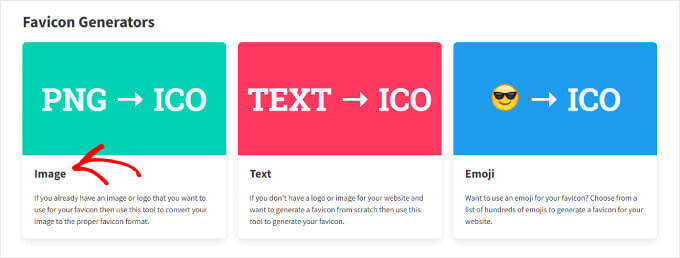
Na próxima página, você pode carregar sua imagem. Em seguida, clique em “Download” para salvar o arquivo zip do favicon, que contém os arquivos favicon.png e favicon.ico.
Certifique-se de manter esta página da Web aberta durante as próximas etapas.
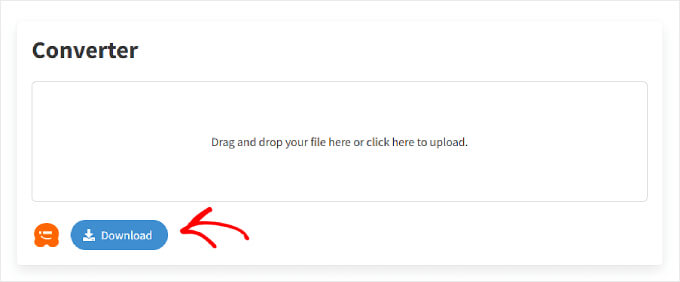
Agora, você precisa carregar o arquivo zip do favicon no diretório raiz do seu site. Para fazer isso, você pode usar o gerenciador de arquivos da sua hospedagem WordPress.
Como alternativa, você pode fazer isso por meio de um cliente FTP como o FileZilla. Para obter mais detalhes, consulte nosso guia para iniciantes sobre como usar o FTP para fazer upload de arquivos para o WordPress.
Depois de abrir os arquivos do seu site por meio do gerenciador de arquivos ou do FTP, navegue até o diretório raiz.
O diretório raiz do WordPress geralmente é uma pasta chamada “public” ou “public_html” e contém pastas essenciais do WordPress, como wp-content e wp-admin.
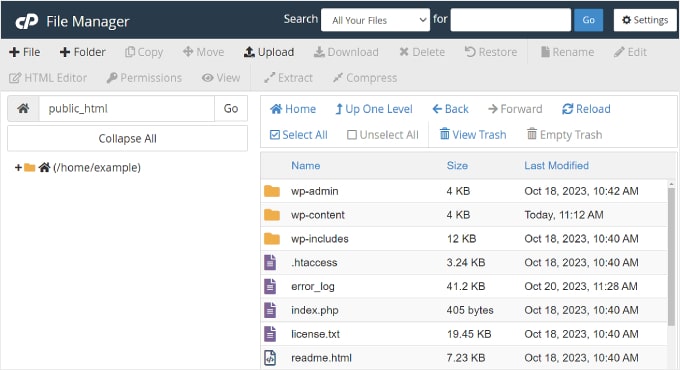
Nesse ponto, você pode extrair e carregar todo o conteúdo do arquivo de favicon que baixou anteriormente para o diretório raiz.
Se estiver usando o File Manager, clique no botão “Upload” próximo à parte superior.

Em seguida, uma nova guia será exibida, solicitando que você carregue os arquivos.
Nessa página, você pode clicar no botão “Select File” (Selecionar arquivo) e escolher todos os arquivos de favicon.
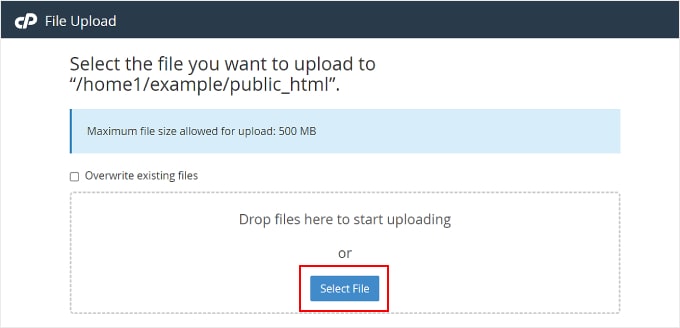
Agora, basta aguardar o upload bem-sucedido dos arquivos.
Uma vez concluído, você pode voltar para a guia do gerenciador de arquivos. Agora você deve ver todos os seus arquivos favicon no diretório raiz, como na captura de tela abaixo:
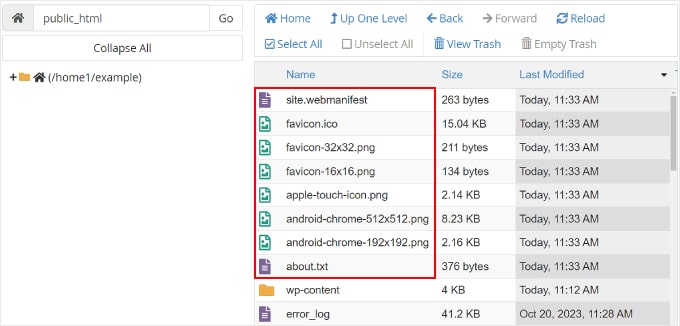
Agora, vamos voltar ao painel de administração do WordPress.
Na barra lateral esquerda, você deverá navegar até Code Snippets ” Header & Footer.
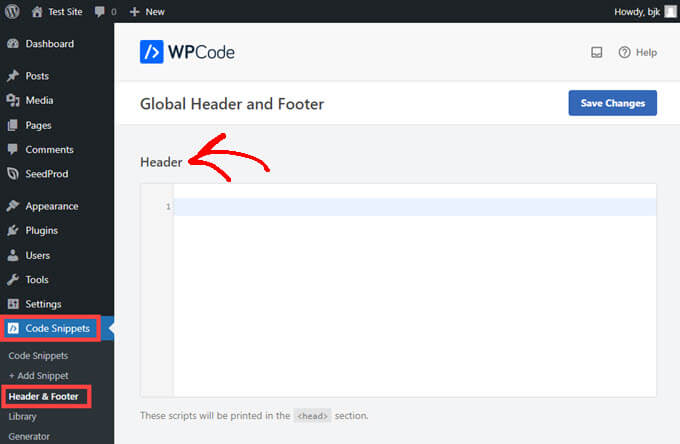
Depois disso, retorne à guia Favicon.io de antes.
Em seguida, você precisa copiar o código HTML de lá. Ele deve ter 4 tags de link rel no código.
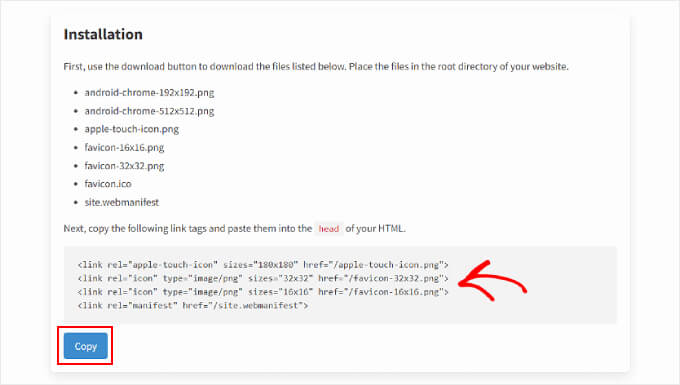
Em seguida, é necessário voltar ao WordPress e colar o código na seção “Header” (Cabeçalho) da página WPCode. Isso adicionará o código ao arquivo header.php de seu site.
No código, insira o URL completo de seu site entre aspas ao lado de todos os atributos href, como no exemplo abaixo. Lembre-se de adicionar http:// ou https:// se seu site usar um certificado SSL.
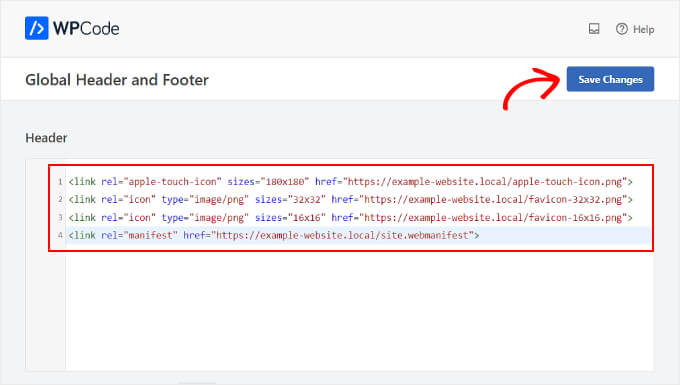
Por fim, você pode clicar no botão “Save Changes” (Salvar alterações) no canto superior direito.
E é isso! Não se esqueça de visitar seu site para ver se a alteração do favicon foi bem-sucedida.
Por que meu favicon do WordPress não está sendo exibido?
Um motivo pelo qual o favicon do WordPress pode não estar sendo exibido é o cache do navegador. Isso significa que seu navegador ainda está exibindo a versão antiga do seu site.
Para resolver esse problema, você precisa limpar o cache do navegador. Se precisar de ajuda, siga nosso guia sobre como limpar o cache do navegador.
Também é possível que você esteja usando um serviço de CDN que ainda armazena a versão antiga do seu site. Nesse caso, você precisa limpar o cache da CDN para atualizar o conteúdo do seu site.
Para verificar se o ícone do seu site WordPress foi carregado, você pode abrir seu site no modo de navegação anônima ou em uma janela de navegação privada.
Se a instalação do favicon não tiver sido bem-sucedida, você poderá tentar recarregar a imagem com um nome de arquivo diferente para resolver o problema.
O recurso de ícone do seu site WordPress também pode não estar funcionando devido a um erro de conteúdo misto. Para resolver esse problema, confira nosso guia sobre como corrigir erros de conteúdo misto no WordPress.
Em alguns casos, você também pode descobrir que seu site está exibindo o favicon do seu provedor de hospedagem em vez do seu próprio. Se isso acontecer, entrar em contato com a equipe de suporte pode ajudar a resolver o problema.
Recomendamos escolher um serviço de hospedagem WordPress respeitável com excelente suporte ao cliente para resolver problemas como esse de forma eficaz. Você pode conferir nossa lista dos melhores provedores de hospedagem WordPress para encontrar a melhor opção para seu site.
Por fim, talvez você queira verificar se o seu tema do WordPress tem uma ferramenta específica para carregar um favicon. Isso pode explicar por que os métodos acima não funcionam para você.
Esperamos que este artigo tenha ajudado você a adicionar um favicon ao seu site WordPress. Talvez você também queira ver nossas escolhas de especialistas sobre os melhores criadores de logotipos gratuitos para ajudá-lo a parecer um profissional e nosso guia sobre como adicionar facilmente fontes de ícones ao seu tema do WordPress.
Se você gostou deste artigo, inscreva-se em nosso canal do YouTube para receber tutoriais em vídeo sobre o WordPress. Você também pode nos encontrar no Twitter e no Facebook.





mohadese esmaeeli
In my opinion, having a favicon can attract the audience’s attention and add a stylish and aesthetic touch to the website in the browser. Perhaps it can capture the viewer’s gaze and be a distinctive feature.
mohadese esmaeeli
Hello. The favicon section of my website is not working. Even when I provide the url in the theme settings, it doesn’t show. I also tried from the site ID part, but it gives an error of not processing the image. Can you please guide me on this?
WPBeginner Support
If you are using the built-in option for your theme then we would first recommend reaching out to your theme’s support as they may have a specific requirement for the favicon image using their tool.
Admin
Jiří Vaněk
The last time I uploaded a favicon to a website, I struggled for a really long time with the icon not showing up on the website. I cleared the browser cache and wordpress itself and it didn’t help. She didn’t show up on her own until a few hours later. If someone is having trouble with it, the cache can be in many places. CDN, on the network element at home, on the server. So sometimes it’s good to just wait a while and not stress right away. Otherwise, the Favicon is a small thing, but it is a great way to customize your own page.
WPBeginner Support
Having a favicon can help with your SEO as well as to help users remember your site but it is not required and the first favicon you set can be changed to a different one later on.
Admin
Peter Iriogbe
Now I see why site owners stick to using Favicon which looks the same as their site logo.
Peter Iriogbe
Is it a must to upload a favicon or does it influence ranking on search?
Jiří Vaněk
Favicon is not necessary and does not affect SEO and search in any way. It is the personalization of the page. A favicon is great in two ways. If someone adds your page to their favorites, they will immediately recognize it by the favicon and do not have to search for a long time. The second great thing is when you have multiple pages open in your browser. You can also recognize the given page immediately by the favicon. So I definitely recommend having it, even if it doesn’t really affect SEO and search itself.
mohadese esmaeeli
Exactly, I agree. I’ve experienced the same issue. Often, when searching, I open various websites, and after an hour, I realize I have many tabs open in the Chrome browser, right in front of my eyes! However, having a favicon helps me quickly locate my desired site among the numerous tabs.
Javi
second alternative worked, thanks
WPBeginner Support
Glad to hear it worked
Admin
Meer Hamza
Is it manadatory to upload favicon at wordpress website in ICO file format.
WPBeginner Support
No, it does not need to be an ico format.
Admin
Meer Hamza
1-Is it ok to just upload site Icon from theme>customize>site Icon. Will it show as favicon?
2-I upload site Icon on wordpress website. Is it necessary to show Favicon at URL website.com/favicon
WPBeginner Support
1. Yes it is fine to upload it from there
2. It is not necessary but it can be helpful for finding the favicon later.
Admin
Alex Perry
Thanks, after 2 hours of searching I finally found it. How to change the site icon…
WPBeginner Support
Glad our guide allowed you to add it instead of needing to search further
Admin
Ben
I think this needs an update. I tried this and there’s no “Site Identity” tab under Appearance > Customize
WPBeginner Support
Your specific theme may have a custom editor or if you are using the block editor you could add the site logo block, set an image, and in the block’s settings have that set as the site’s favicon.
Admin
FAIZ
what a great guide, really it’s very helpful
WPBeginner Support
Happy to hear our guide was helpful
Admin
Max Anderson
What does the WPBeginner favicon represent?
WPBeginner Support
Our blob is a simple design of a face smiling using an exclamation point and parenthesis
Admin
AL
Hi, what to do when Favicon is not showing on chromium-based browser and shows up in Firefox.
WPBeginner Support
You would normally want to clear your site’s cache as well as try setting the favicon again for a common reason.
Admin
John
I’m new to this so would appreciate some guidance with favicon. The website I’m trying to look after needs the favicon changing. Can I load a new image as a favicon that will overwrite the favicon currently on the pages or must i delete the current one then load a new image?
Thanks for any reply
WPBeginner Support
You would want to reach out to the support for your specific theme for if your theme has this option.
Admin
Ray
I was fine on the video until you said “click on site identity”… there is no such tab on my version. The first option is “Global” then Header, Breadcrumb, UberMenu{main], Blog, etc. No “Site Identity”…so obviously without being to get to that screen I’m not going anywhere. Is there another way in?
WPBeginner Support
If your theme has different settings and you are unable to find the favicon in the customization settings, you would want to reach out to the support for your specific theme to see if they have it located in a theme-specific area.
Admin
Krishna
Hii Wpbeginner!
I’m using Astra theme my website Favicon is working every one except Google search results. How can I fixed it?
WPBeginner Support
You would need to wait for Google at the moment.
Admin
Soul sultan
This is the awesome guide about how to add favicon on wodpress blog
WPBeginner Support
Thank you, glad you found our content helpful
Admin
Shomirul Islam Bonny
Thanks! It helped me!
WPBeginner Support
You’re welcome, glad it helped
Admin
Munendra Singh
all helpful post,, thanks
WPBeginner Support
Glad you found our post helpful
Admin
Raj
Great ! I always go through from your tutorials when ever i get stuck in any kind of issue. Thanks for it.
WPBeginner Support
Thanks, glad our articles could help
Admin
John Barson
Can’t Add a Favicon to Your WordPress Website? That was my problem. I did a fair bit of research where I finally found my issue. It was because the PHP GD Library was not enabled. Fortunately, I control my own server. I had upgraded the server PHP to v7.2 but I forgot to enable the PHP GD library. So…if you find when you try to add the site icon in the appearances section of your wordpress admin and the image you upload/select is not being accepted or you can’t use the crop image feature it is most likely because your webserver host has not enabled the GD Library.
WPBeginner Support
Thanks for sharing this information should someone else run into that issue
Admin
Cean Herzfield
Thank you so much! You saved me a lot of frustration because I’m working on Xampp and it was disabled by default. Now wouldn’t it have been nice if they had mentioned it in the article.
Pritam
Favicon of my website was visible before I changed DNS for Cloudflare. Now it is visible in the admin side but not on the website. How to solve this problem. you can check on my website
Michele A
This tutorial was wonderful! Thank you so much for the great work!
Jacques
My Favicon is updating in ADMIN side, but not on user side
Tracy
Were you able to figure out how to fix it?
RAJ
“When I go to the “Site Identity” tab, there is no place to upload a site icon. The only option I have is the “Site Title”. That’s ALL!
I am using WordPress 4.7.3.”
Bekzat Sadykov
I guess, the WP theme you are using doesn’t have favicon implemented. So, if it is not declared in theme functions.php file, it won’t appear in admin/editor side.
You can hardcode it to header.php or use third-part plugins.
jacob
scroll down a little you will see the place to upload your favicon
Eleanor
Hi, I recently updated my website from HTTP to HTTPS and when that happened, the site icon stopped working. Does this mean that somewhere along the line I’ve missed a step? I’ve tried changing the image and reuploading a new one and that hasn’t worked. If someone types in the website URL using http then the old favicon (and not site icon) shows up, but the minute it’s https, then it disappears. The site icon though is visible when I’m logged into the dashboard.
Matt Parker
Eleanor
I’m on HTTPS and I have the same issue, did you find a solution?
Favicon only shows when I’m logged in in admin mode!
Jimmy
When I go to the “Site Identity” tab, there is no place to upload a site icon. The only option I have is the “Site Title”. That’s ALL!
I am using WordPress 4.7.3.
Please help!
Ahmed Akeem
I guess, the WP theme you are using doesn’t have favicon implemented. So, if it is not declared in theme functions.php file, it won’t appear in admin/editor side.
You can hardcode it to header.php or use third-part plugins.
Abubakar Sahabi Rafi
It really helped, more grease to our elbow.
Tim
Can anyone tell me how this new “Site Icon” feature is supposed to work? I get to the point where the file is uploaded and I get a dialog box that offers to crop the image. The problem is 1) my image doesn’t need to be cropped and 2) there’s no “Save” button (or “Done” or anything similar), only a “Crop” button and the upper right corner X to close the dialog. If I click “Crop” I get an error (Error cropping this image, bla bla bla) and if I hit the X it closes. Either way, my image is not saved as a Site Icon (even though it is saved in the media library. After deleting the image, resizing it to exactly 512×512, I upload it again. This time, no crop dialog, just the “Select” image dialog. I click select, the image has a box around it and a check mark and nothing else happens. No Save, etc. When I close the dialog, there’s still “No image selected.” This happens in Chrome AND Firefox. I’m ready to throw WordPress away and hand code everything. I haven’t used WordPress in a couple of years and I’m frustrated with what seems like buggy, poor design and feature bloat.
Brian
code easy to interpret, it worked out. thanks…
Jason
Why does it need to be 512 pixels for an icon? I’m hoping it’s converted somewhere inside WordPress, once and done, and not on every load. 512×512 is crazy for something that would very rarely be bigger than 32X32, unless I am missing something?
John Krawczyk
Article not useful. Everyone tells you to make a path to your favicon & that’s it.
However do you include http: www http do you specify .ico .png?
Nobody says anything in detail.
WPBeginner Support
Hi John,
Yes you need to include full URL like this:
https://www.wpbeginner.com/favicon.pngAdmin
Joe
Using WP4.7 and the Site Icon functionality works, but it just seems off to me. The result is 4 links in the section:
But it creates 10 different versions of the site icon image in addition to the original at sizes of 32×32, 100×100, 150×150, 180×180, 192×192, 250×250, 270×270, 300×300, 360×360, 500×310.
Why so many cropped images if only 4 linked to?
Also, I submit an icon image sized 512×512 as recommended, but the 500×310 version is always cropped so the top and bottom of the icon is cut off. Is there any way around this and/or is it a big deal?
What browser support does this WP Site Icon cover (mostly in respect to how far back in IE)?
Thanks!
Marieke
In Whatsapp, the image which appears left to a link address if you send a link: is that the same icon? Because I don’t see it there.
Sunil
Marieke, It’s featured image, you upload to a particular post.
Cos
The ICO Format plugin for Adobe Photoshop does not allow images more than 256 pixels high or wide. So how do you create one that’s 512px???
Marieke
It doesn’t need to be made an .ico. Just a plain .png or .lpg will do when you work in WordPress.
Salim Ahmed
Informative instruction. Now i following your tips and tricks. Thanks for sharing it.
Taimoor Ahmed
Kindly tell me any website or a software from where I can make an effective favicon for my site in a quick time????
Kirstie
Thank you for another simple to follow tutorial. I’m a true beginner and y’all do a great job explaining things in a way I can understand.
WPBeginner Support
Thanks, glad you find our tutorials helpful.
Admin
Nelson
thanks good tut easy and works
c
the add logo in some themes isn’t for favicon its for the header logo
ccstacyline
how come my side identity menu doesn’t have the service for site icon? I am so frustrated… can you help ?
John Davis Frain
Are the instructions you give here theme-specific? I’m using the Delicacy theme, and it doesn’t give me that option to alter Site Identity and insert a Favicon.
WPBeginner Support
No it is not theme specific. Make sure you are using the latest version of your theme.
Admin
Mad Dog Malcs
Hi There, I also don’t see the site identity tab, I am using the sketch theme, how do I update a theme?
Thanks in advance, Malcs
shashi
i may go to theme custimztion..there u see the option of uploading the favicon icon easliy…
Antonios
You might not see the word “favicon” probably site icon. If you see a scrow bar you might have to scrow all the way down to see the select image box.
a
You can add favicon by WordPress’ “Costumize” editor, which can be found in every wordpress site.
Alan
I upload a PNG file that is exactly 512×512 pixels, WordPress saves it, and then I end up with a cropped image in my media library. Super annoying! WordPress 4.4.
Alan
I should add that the new, cropped image is exactly the same dimensions as the original I uploaded, but now I have two in my library (albeit one has been processed twice, and has actually increased two kilobytes in file size!).
Katherine Johnston
I have gone through the directory, exactly as you described, but my Site Identity tab only has “Site Title”, “Tagline”, and a checkbox for displaying header text. How can I fix that? Or do I have to go the FTP route?
Thanks for the help!
Rahul Thakur
thank you so much, very simple way love it.
Liz
Excellent instructions, took me about 32 seconds to do it. Fabulous! Thank you
Erin
Thanks! This was very helpful.
Marie Bock
Wow! That was so easy with the newer version of WordPress.
Matt
Super-easy! Thanks for that – I just need to go away and design a better logo now
Viscoun
Doesn’t work. When I got to Customize > Site Identity, the site icon option doesn’t show up – it only says “Site Title” and “Tagline”.
david
what version of wordpress are you using?
Harshpreet
Hi same is the problem I am facing and I am using the website of wordpress on my laptop for building up my blog!
Gina
I’m having the same problem. I’m using wordpress directly online, I haven’t downloaded anything. No “site icon” option at all.
WPBeginner Support
Please see our guide on the difference between self hosted WordPress.org vs free WordPress.com blog.
Admin
Lourika
It took me forever to figure it out!!!!
In the top left corner, click on MY SITES
Go to WP Admin
Then click on SETTINGS
and you will be able to change the icon (picture) on the right hand side……